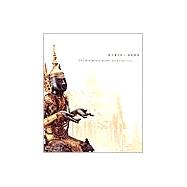Doris Duke : The Southeast Asian Art Collection
, by Tingley, Nancy- ISBN: 9780824827731 | 0824827732
- Cover: Hardcover
- Copyright: 7/1/2003
In 1925, twelve-year old Doris Duke inherited a substantial fortune from her father, James B. Duke, a successful industrialist whose family founded the Duke Power Company and the American Tobacco Company. Doris Duke was an intensely private women who disdained the celebrity that she inherited along with her wealth. In 1935 at age 22, she embarked on a honeymoon journey around the world, visiting Egypt, the near East, India, Singapore, Bangkok, Indonesia, the Philippines, Hong Kong, and Japan, as well as sites in Europe. The cultures of Asia sparked Doris Duke's passion for Islamic and Southeast Asian art and culture, which in turn shaped the course of her life's work and cultural endeavors.
Inspired by her honeymoon travels, Doris Duke built a winter home in Honolulu in the late 1930s called Shangri La, which houses the vast and unique collection of Islamic art that she assembled over more than 60 years. In 1957, Doris Duke returned to Thailand for the first time since her honeymoon, and its art and culture subsequently became a major focus of her collecting. Over the next few years, she would embark on a new project: to recreate and furnish a Thai village - complete with a replica of a pavilion from the temple compound of the Royal Palace in Bangkok - to educate the American public about Southeast Asian art and culture. She envisioned the village as a gift for the people of Hawai'i.
Doris Duke: The Southeast Asian Art Collection features some of the objects she collected for the Thai Village Project, and reveals the passion and talent of Doris Duke as a collector. It informs readers about the historical significance of the art and offers substantial visual rewards. The author contextualizes and describes objects in three main areas of the collection: sculpture, painting, and decorative and performing arts. This book's 100 plates and figures illustrate over 200 of the more than 2,000 objects in Doris Duke's collection, including works from Thailand, Burma, Cambodia, and China that exemplify the breadth and quality of the collection: tall, elaborately carved pulpits from which a Buddhist priest would address worshippers and monks; gilded figures of the Buddha; painted banners depicting the life of the Buddha; accordion-folded manuscripts and their decorated storage boxes; tall cabinets used for manuscript storage; offering vessels inlaid with mother-of-pearl, lacquer, nielloware, and the bencharong ceramics made in China for the Thai market; carved ivory objects; and weapons.
Inspired by her honeymoon travels, Doris Duke built a winter home in Honolulu in the late 1930s called Shangri La, which houses the vast and unique collection of Islamic art that she assembled over more than 60 years. In 1957, Doris Duke returned to Thailand for the first time since her honeymoon, and its art and culture subsequently became a major focus of her collecting. Over the next few years, she would embark on a new project: to recreate and furnish a Thai village - complete with a replica of a pavilion from the temple compound of the Royal Palace in Bangkok - to educate the American public about Southeast Asian art and culture. She envisioned the village as a gift for the people of Hawai'i.
Doris Duke: The Southeast Asian Art Collection features some of the objects she collected for the Thai Village Project, and reveals the passion and talent of Doris Duke as a collector. It informs readers about the historical significance of the art and offers substantial visual rewards. The author contextualizes and describes objects in three main areas of the collection: sculpture, painting, and decorative and performing arts. This book's 100 plates and figures illustrate over 200 of the more than 2,000 objects in Doris Duke's collection, including works from Thailand, Burma, Cambodia, and China that exemplify the breadth and quality of the collection: tall, elaborately carved pulpits from which a Buddhist priest would address worshippers and monks; gilded figures of the Buddha; painted banners depicting the life of the Buddha; accordion-folded manuscripts and their decorated storage boxes; tall cabinets used for manuscript storage; offering vessels inlaid with mother-of-pearl, lacquer, nielloware, and the bencharong ceramics made in China for the Thai market; carved ivory objects; and weapons.






